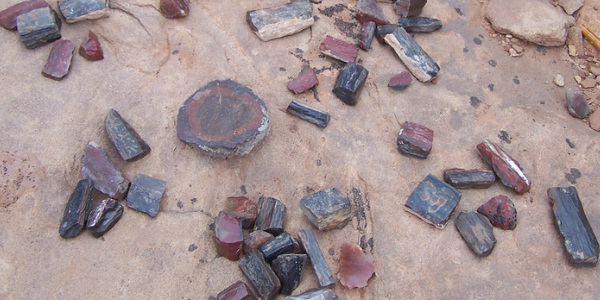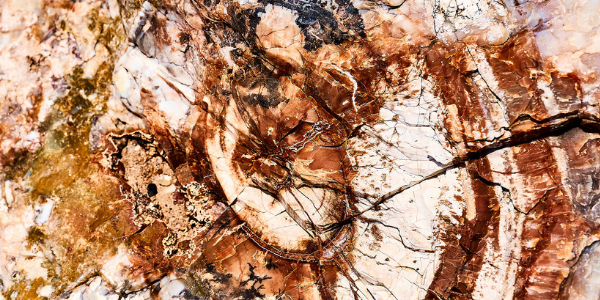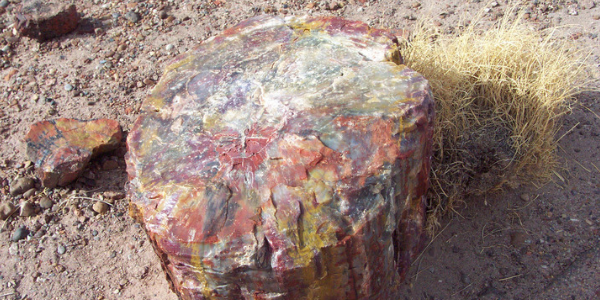
When I was seven or eight, my grandfather showed me a collection of stones he kept in a hardware storage rack in his basement. Picture many small drawers filled with a variety of stones, each one a mystery. As a child they entranced me. And Grandad had a fantastical story about each one.
The little drawer that most captured my attention was the one containing what looked like wood, but was cold and hard in my hand. “Petrified wood,” my grandfather called it. Many times I pleaded for him to open the drawers and let me hold the petrified pieces. He recognized my delight and at some point gave me a small piece to keep. Cool and hard in my hand, with pink and brown striations, Petrified Wood was my first sacred stone. I knew it had magical powers because it came from a magical forest that Grandad described.
From the Latin petro meaning rock or stone, petrified wood is the fossilized remains of trees or terrestrial vegetation. Petrified wood is literally wood that has turned to stone through the process of permineralization, in which the organic material of the tree becomes replaced with inorganic materials — in this case silicate minerals like quartz. Carried by water, the minerals fill the spaces within the organic tissue hardening it over time.
“All of time is contained in this wood,” Grandad told me, “That tree knows about everything that ever happened while it was alive, and since it died and fell down. It contains history in its cells. It’s no wonder it’s so hard.”

Like fossils, petrified wood is the result of a tree being buried in an anaerobic (without oxygen) environment, covered by layers of sediment or volcanic ash. While fossils are often impressions or compressions of the original organic material, petrified wood retains its original stem tissue structure and is a three-dimensional hardened version of the original tree material. Because there is no oxygen, the organic material doesn’t decompose completely, and over time stone mold forms in place of the cellulose structures.
Many samples of petrified wood have the distinguished concentric rings that denote a trees age while living. Many samples also have distinct wood and bark material preserved. Ranging in size from a pebble to massive tree sized samples, and in diameter from a twig to a trunk, Petrified Wood is abundant in the areas where the geological conditions for its creation existed.
Clutching my small stone in my tiny hand, I listened to Grandad describe how he found the petrified wood. As he spoke, I imagined a forest of hardened trees, each one with a face. Old faces, knowing faces, caring faces. When he told me they were all laying down in the dessert, some whole tree trunks, some just parts and pieces, I envisioned them as wise old women who lay dead on the ground, their bones scattered. I thought of the desert as a huge graveyard.
Related: Connecting with the ancient wisdom of fossil magick, by Dallas Jennifer Cobb
Related: Bless your evolution: A simple fossil magick rite, by Dallas Jennifer Cobb
When he mused about them holding the memory of all time that has passed, I began to see them as sentinels, guardians, and the keepers of wisdom. No longer a sad scene, my imagination helped me to see the persisting spiritual energy of petrified wood.
Because of its age and the process of formation, petrified wood is said to be useful for relieving feelings of paralysis, being stuck or feeling frozen in time. It is a stone that can help in the process of researching, revealing or establishing deep roots, and is deeply grounding, stabilizing the feelings of fear, panic or anxiety. Quietly holding a piece of petrified wood can produce a feeling of security as it calms jangled nerves and dispels stress. With such deep rooted ancient origins, petrified wood can help clarify what path to take, and what is worthwhile or unworthy.

During the Dirty Thirties, my grandad travelled by rail west across Canada and south through the United States in search of work, money, and adventure. For almost three years he worked at many different jobs: painting houses, picking fruit, cleaning streets, and digging ditches. Hopping on and off trains illegally, he was part of a generation of men who went off in search of work during the Depression. Begging meals from the back gates of homes in larger cities, he cut lawns and painted houses in payment.
While in Arizona, he explored the dessert and found pieces of rock that looked like wood. Excited to find something he had never seen before in Muskoka, where he was from, sat on the Canadian Shield which dates from the middle to the late Precambrian Era. Grandad took what he could carry in his pack, and much of that treasure made it all the way home, north and east on the rails.
The area my Grandad travelled through on foot back in the ’30s is now known as the Petrified Forest National Park, established as a national park in 1962.
While my magical association with petrified wood is tied to the memories of Grandad and his magical rock collection, it also includes the black and white images of my grandfather as a handsome young man: before he fought in the Second World War, before he met my Grandmother in England, and before my mother was born — my grandad was an adventurer.
The small piece of petrified wood Grandad gave me links me to my deep roots. I have added other, larger pieces to my own magical rock collection, but when day to day stress threatens to overwhelm me, I seek out my small piece of petrified wood. Holding it, I often think: If Grandad could survive the Depression and World War Two, surely I can survive this.
To learn how to make a spirit bag with petrified wood or other crystals, rocks, or gems, see “Petrified wood spirit bags: Reaching through ancient roots.”
Image credit: Bryant Olsen, Klop Pe, Clinton Steeds







